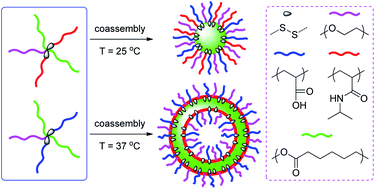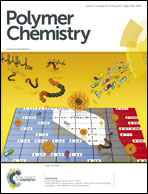Thermo, pH and reduction responsive coaggregates comprising AB2C2 star terpolymers for multi-triggered release of doxorubicin†
Abstract
Novel 5-arm PEG(PCL)2(PNIPAM)2 (S1) and PEG(PCL)2(PAA)2 (S3) star terpolymers were synthesized, and their aggregates formed by a single star or mixed stars were efficiently used for loading and release of doxorubicin upon dual and triple stimuli. The star terpolymers had two disulfide moieties and poly(ethylene glycol) (PEG, A), poly(ε-caprolactone) (PCL, B), poly(N-isopropylacrylamide) (PNIPAM, C1), poly(tert-butyl acrylate) (PtBA, C2), and poly(acrylic acid) (PAA, C3) segments. Terminal diazide functionalized PEG (PEG-(N3)2) and alkyne-mid-functionalized PCL-b-PNIPAM and PCL-b-PtBA diblock copolymers were subjected to an azide–alkyne cycloaddition reaction to generate AB2C2 (C = C1 and C2) stars followed by selective hydrolysis to obtain a PEG(PCL)2(PAA)2 star. Polymeric micelles were prepared by self-assembly of a single star in aqueous solution, and coaggregates were obtained by coassembly of S1 and S3 mixtures. Various polymeric aggregates had great potential as controlled delivery vehicles due to their reasonable drug loading efficiency and stimuli-adjustable drug release properties. As compared with dually sensitive micelles formed from a single star, triply stimuli-responsive coaggregates may be more promising as controlled delivery vehicles since the drug release properties can be potentially adjusted by various external stimuli and composition of star mixtures.


 Please wait while we load your content...
Please wait while we load your content...